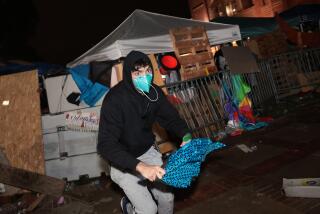Path of Destruction
The worst urban riot in contemporary U.S. history exacted its heaviest tolls in inner-city neighborhoods, but other areas throughout Los Angeles County suffered as well. The violence that left dozens dead, thousands injured and caused hundreds of millions of dollars in property damage in Los Angeles also triggered unrest in the nation. Here is a recap of the effects, many still estimated, the tumult had on people and places:
THE FIRES
Fires: More than 8,000 structure fire calls in city and county; 2,000 in Long Beach. Areas Hardest Hit: South Central Los Angeles, Crenshaw district, Koreatown, Hollywood, Compton and Long Beach Method: Mostly gasoline. Damage estimate: Very tentative, as of May 6th, about 5,200 buildings damaged or destroyed, including at least 1,600 severely damaged or burned businesses. Environmental Impact: Still to be determined. Half of the more than 5,000 burned buildings contained asbestos. In the aftermath of the rioting, storm drains dumpted soot, ashes and other toxic materials into the sea.
CRIME
Areas Hardest Hit: Looting was widespread in many areas but was concentrated in South-Central, Crenshaw, Koreatown, Hollywood, Mid-Wilshire, Echo Park, Silver Lake and Compton. Arrests: More than 17,000, including at least 2,600 felony arrests. Emergency Measures: State government allowed courts to extend arraignment periods an additional seven days. All trials can be postponed an additional 30 days.
INFRASTRUCTURES
Electricity: Damage to Department of Water and Power power poles, lines and transformers: $12.5 million. Customers without power: 35,000. Southern California Edison property damage; $150,000. Customers without power; 10,500. Telephone: Customers who lost service: 240,000. Transportation: Bus Service temporarily suspended; six Rapid Transit District employees attacked and 43 vehicles damaged. Blue Line temporarily suspended. Harbor Freeway off ramps closed for 5 days. Natural Gas: No widespread service losses except 25 outages along Vermont Avenue during rioting.
MEDICAL HELP
Hospitals Involved: The Southern California Hospital Council polled the 26 hospitals that treated the majority of riot victims, although a total of 87 hospitals saw victims of the unrest. Among the key hospitals: Major Hospitals: Martin Luther King/Drew Number Treated: 206 Major Hospitals: Daniel Freeman Memorial Number Treated: 160* Major Hospitals: County--USC Number Treated: 145 Major Hospitals: Good Samaritan Number Treated: 63** Major Hospitals: Harbor-UCLA Number Treated: 58** Major Hospitals: Centinela Number Treated: 44 Major Hospitals: Queen of Angels/Hollywood Presbyterian Number Treated: 40 * April 29-May 5. ** April 29-May 2. Others April 29-May1.
THE WOUNDED
Total Number Wounded: 2,383. Of those, 1,850 sought emergency room treatment in the 26 busiest hospitals. Of those seen in the emergency room:
269 had injuries caused by assaults
198 had gunshot wounds
57 had stab wounds
17 had burns
463 had miscellaneous injuries including broken bones, cuts, contusions Of those with critical injuries:
63 gunshot wounds
26 assault victims
17 stabbing victims
5 burn victims
13 miscellaneous, including auto accident injuries
THE DEAD
In total, 58 people died as a result of the rioting, according to the coroner as of Saturday afternoon. The first fatality occured at 8:15 p.m. Wednesday, and the last known death occured at 10:05 p.m. Sunday. Here is a breakdown: Race: Black: 26 Latino: 18 White: 10 Asian: 2 Unknown: 2
Method: Gunshot: 41 Traffic/Accident: 7 Arson: 3 Natural: 1 Assault: 2 Other: 4
Sex: Males: 51 Females: 7 TOTAL: 58
OTHER AREAS
In the hours and days after the verdict, sporadic violence flared. Among the incidents: San Francisco: Demonstrators loot stores and set fires downtown. State of emergency declared. More than 1,500 people arrested. Las Vegas: Mob throws rocks and bottles. About 20 buildings burned. One person found dead. Atlanta: Mob attacks commuters at a subway station. Some looting, numerous arrests. Tampa, Fla.: Youths throw rocks and bottles. Seattle: Mobs overturn cars, break windows. Toronto, Canada: 1,000 people go on six-hour looting rampage. Violence continues over several days. Washington, D.C.: Demonstrators block traffic on a main bridge for about two hours.
THE PROTECTION FORCES
FIRE DEPARTMENT AND PARAMEDICS
Maximum Deployment: City--2,000 firefighters, 120 paramedics at any one time.
County--800 firefighters and paramedics at any one time. Responses: Estimated 7,700, some of which wre repeat calls. Other Departments Helping: About 92 fire agencies, from as far north as Eureka and as far south as San Diego, provided help. Estimated Cost: City--$12.1 million (estimated). County--not available.
LOS ANGELES POLICE DEPARTMENT
Maximum Deployment: 5,000, up to 2,500 per shift. Other Departments Helping: 600 to 800 officers from as far away as San Diego and the Bay Area. Estimated Cost: $1.25 million for every 24-hour period.
LOS ANGELES COUNTY SHERIFF
Maximum Deployment: 1,000 Responses: Policed unincororated areas of Los Angeles.
LOS ANGELES COUNTY MARSHALS
Maximum Deployment: 950, including 700 deputies and 250 support personnel. Number Wounded: 0 Overtime: at least 3,500 hours.
CALIFORNIA HIGHWAY PATROL
Maximum Deployment: 2,323 officers at peak of unrest, including 1,446 from other divisions within California Other: Also deployed 53 officers in San Francisco, 48 of whom were from the cadet class sworn in a week early.
FEDERAL TROOPS
Maximum Deployment: 3,313, including 1,769 members of the U.S. Army from Ft. Ord, and 1,544 U.S. Marines from Camp Pendleton. Also, at peak of unrest, about 1,000 U.S. law enforcement officers including FBI and Border Patrol agents.
CALIFORNIA NATIONAL GUARD
Maximum Deployment: 9,975 from all over California, including as far north as Eureka and as far south as San Diego. Responsibility: Assist law enforcement officers in securing areas and in protecting firefighters. No authority to make arrests. Most of the guards are from military police, artillery, combat engineer units.
Researched by: Michael Meyers, Tracy Thomas and Helene Webb
More to Read
Sign up for Essential California
The most important California stories and recommendations in your inbox every morning.
You may occasionally receive promotional content from the Los Angeles Times.










